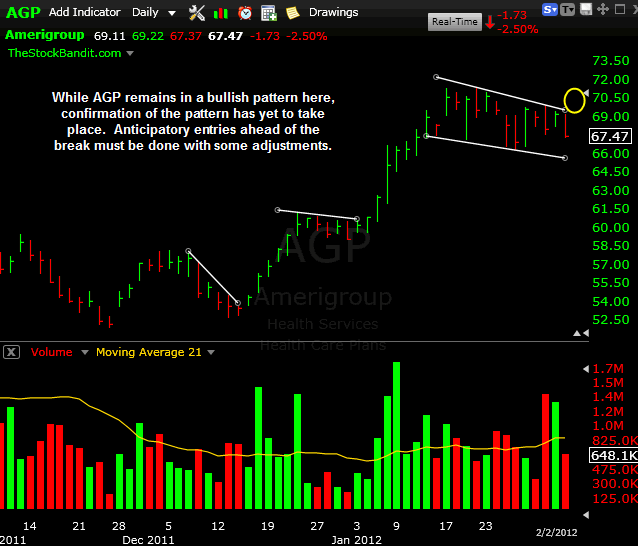Why Anticipatory Trading is so Tricky
TheStockBandit
Publish date: Fri, 03 Feb 2012, 09:25 AM
Charts give us the opportunity to wait for confirmation or enter ahead of time – to anticipate.'' And while the latter may give us more of a feeling of being right, it’s not an easy way to trade.
Here’s an example from this week…
AGP is sitting in a bullish consolidation pattern here within an existing uptrend.'' This is a quality pattern – but it has yet to confirm.'' A breakout would happen beyond the upper channel trend line, currently at $70.'' Check out the setup, then down below let’s discuss trading it.

This is a setup which would have delivered some frustration for those anticipating a breakout – at least for those who entered early.'' Wednesday saw a move back up toward the upper channel line, suggesting a breakout was perhaps coming soon, only to have a decisive turn lower on Thursday bring it right back into the center of the channel.'' The stock is again lower this morning.
There’s a huge difference between how pro’s and amateurs make anticipatory trades, let’s see what they are and what those choices lead to.
How Amateur Traders Anticipate
Many amateur traders make anticipatory trades.'' They receive a tip, or they have a hunch, or they just want to see their predictions proven, and they get in before any bit of a move has started.'' They load up, then wait to get paid.'' A failure of the stock to deliver the move results in the max loss possible under this circumstance, all because of how the amateur entered the trade.
How Professional Traders Anticipate
Many professional traders make anticipatory trades as well.'' Their experience provides them with market feel, and when watching the tape and eyeing the charts, they’ll run across trades they like too – maybe even the exact same setups as the amateur finds.'' However, their execution methods are worlds apart.
Rather than piling into the trade and sitting back and hoping the market proves them correct, the professional enters a feeler position – a starter.'' A trade small enough to watch but not big enough to hurt them or really help them.'' It’s a marker.'' As the trade begins to prove itself and the pattern starts to confirm, they add to the trade.'' They build a position as it works, allowing them to get paid nicely when their hunch proves correct.'' A failure of the stock to deliver the expected move results initially simply leaves them stopping out of their starter position for the bare minimum loss.
See the difference between the two?
There’s a big argument to be made for just waiting for confirmation in a pattern to take place before entering a trade, but anticipatory trading can still produce profits, so long as you’re doing it carefully.
For those of you anticipatory traders, the example above is a great example of how to finesse your entry.'' Scale in, make the setup confirm before adding, and know you’re covered either way – whether a tiny loss you can easily survive or a winning trade you can build on.
(For more on anticipatory trading, read When to Make Anticipatory Trades.)
Trade Like a Bandit!
Jeff White















